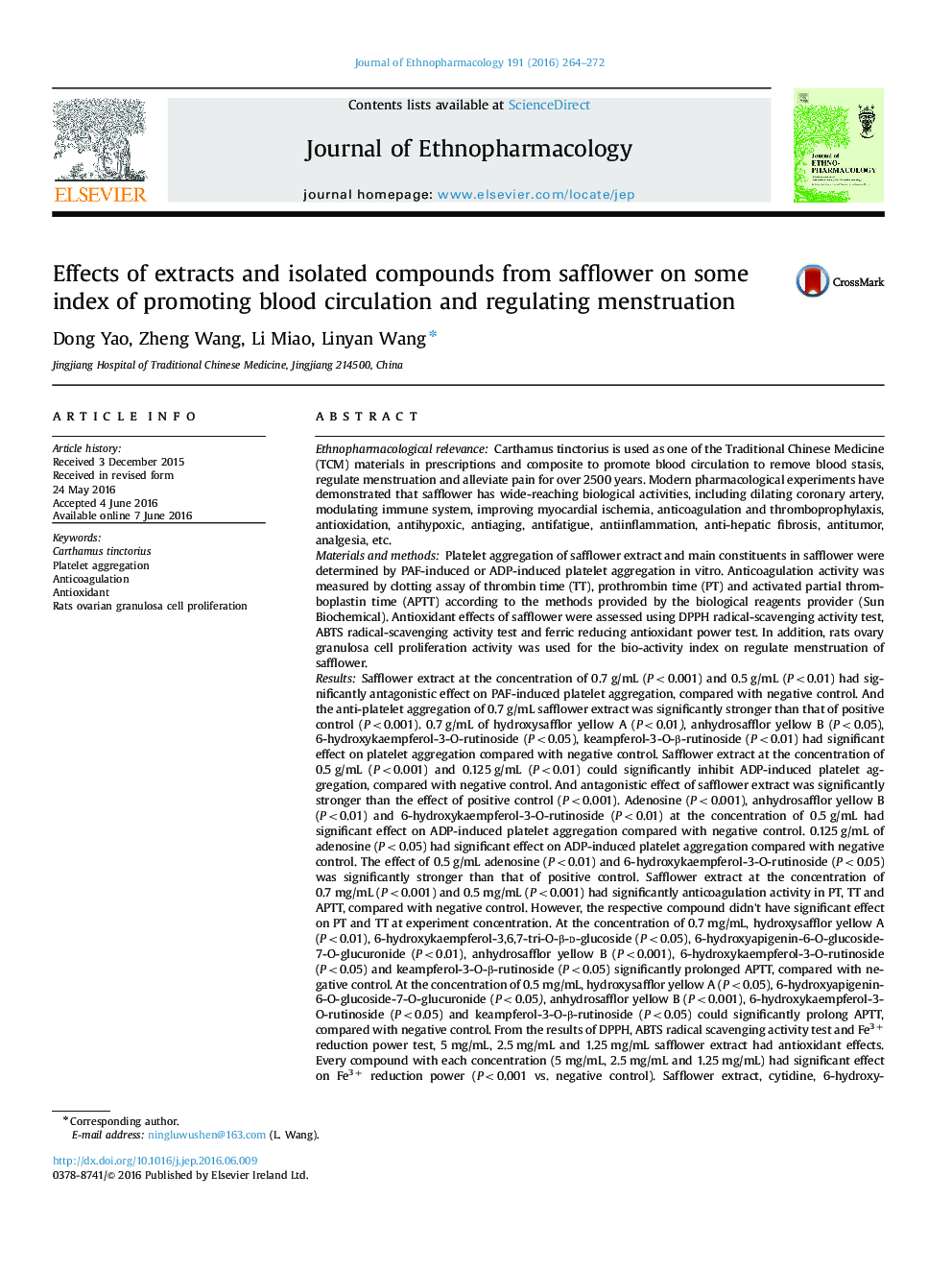| کد مقاله | کد نشریه | سال انتشار | مقاله انگلیسی | نسخه تمام متن |
|---|---|---|---|---|
| 2544589 | 1560371 | 2016 | 9 صفحه PDF | دانلود رایگان |
Ethnopharmacological relevanceCarthamus tinctorius is used as one of the Traditional Chinese Medicine (TCM) materials in prescriptions and composite to promote blood circulation to remove blood stasis, regulate menstruation and alleviate pain for over 2500 years. Modern pharmacological experiments have demonstrated that safflower has wide-reaching biological activities, including dilating coronary artery, modulating immune system, improving myocardial ischemia, anticoagulation and thromboprophylaxis, antioxidation, antihypoxic, antiaging, antifatigue, antiinflammation, anti-hepatic fibrosis, antitumor, analgesia, etc.Materials and methodsPlatelet aggregation of safflower extract and main constituents in safflower were determined by PAF-induced or ADP-induced platelet aggregation in vitro. Anticoagulation activity was measured by clotting assay of thrombin time (TT), prothrombin time (PT) and activated partial thromboplastin time (APTT) according to the methods provided by the biological reagents provider (Sun Biochemical). Antioxidant effects of safflower were assessed using DPPH radical-scavenging activity test, ABTS radical-scavenging activity test and ferric reducing antioxidant power test. In addition, rats ovary granulosa cell proliferation activity was used for the bio-activity index on regulate menstruation of safflower.ResultsSafflower extract at the concentration of 0.7 g/mL (P<0.001) and 0.5 g/mL (P<0.01) had significantly antagonistic effect on PAF-induced platelet aggregation, compared with negative control. And the anti-platelet aggregation of 0.7 g/mL safflower extract was significantly stronger than that of positive control (P<0.001). 0.7 g/mL of hydroxysafflor yellow A (P<0.01), anhydrosafflor yellow B (P<0.05), 6-hydroxykaempferol-3-O-rutinoside (P<0.05), keampferol-3-O-β-rutinoside (P<0.01) had significant effect on platelet aggregation compared with negative control. Safflower extract at the concentration of 0.5 g/mL (P<0.001) and 0.125 g/mL (P<0.01) could significantly inhibit ADP-induced platelet aggregation, compared with negative control. And antagonistic effect of safflower extract was significantly stronger than the effect of positive control (P<0.001). Adenosine (P<0.001), anhydrosafflor yellow B (P<0.01) and 6-hydroxykaempferol-3-O-rutinoside (P<0.01) at the concentration of 0.5 g/mL had significant effect on ADP-induced platelet aggregation compared with negative control. 0.125 g/mL of adenosine (P<0.05) had significant effect on ADP-induced platelet aggregation compared with negative control. The effect of 0.5 g/mL adenosine (P<0.01) and 6-hydroxykaempferol-3-O-rutinoside (P<0.05) was significantly stronger than that of positive control. Safflower extract at the concentration of 0.7 mg/mL (P<0.001) and 0.5 mg/mL (P<0.001) had significantly anticoagulation activity in PT, TT and APTT, compared with negative control. However, the respective compound didn’t have significant effect on PT and TT at experiment concentration. At the concentration of 0.7 mg/mL, hydroxysafflor yellow A (P<0.01), 6-hydroxykaempferol-3,6,7-tri-O-β-d-glucoside (P<0.05), 6-hydroxyapigenin-6-O-glucoside-7-O-glucuronide (P<0.01), anhydrosafflor yellow B (P<0.001), 6-hydroxykaempferol-3-O-rutinoside (P<0.05) and keampferol-3-O-β-rutinoside (P<0.05) significantly prolonged APTT, compared with negative control. At the concentration of 0.5 mg/mL, hydroxysafflor yellow A (P<0.05), 6-hydroxyapigenin-6-O-glucoside-7-O-glucuronide (P<0.05), anhydrosafflor yellow B (P<0.001), 6-hydroxykaempferol-3-O-rutinoside (P<0.05) and keampferol-3-O-β-rutinoside (P<0.05) could significantly prolong APTT, compared with negative control. From the results of DPPH, ABTS radical scavenging activity test and Fe3+ reduction power test, 5 mg/mL, 2.5 mg/mL and 1.25 mg/mL safflower extract had antioxidant effects. Every compound with each concentration (5 mg/mL, 2.5 mg/mL and 1.25 mg/mL) had significant effect on Fe3+ reduction power (P<0.001 vs. negative control). Safflower extract, cytidine, 6-hydroxy-kaempferol-3,6-di-O-β-d-glucoside-7-O-β-d-glucuronide, 6-hydroxykaemp-ferol-3,6,7-tri-O-β-D-glucoside and keampferol-3-O-β-rutinoside significantly promoted ovarian granulosa cell proliferation.ConclusionBased on previous researches, the activities of safflower extract and pure compounds isolated from safflower were studied in this paper. This study found some compounds with the effects of anti-platelet aggregation, anticoagulation, antioxidation and ovarian granulosa cell proliferation, and further revealed the possible pharmacological mechanism of safflower.
Figure optionsDownload high-quality image (286 K)Download as PowerPoint slide
Journal: Journal of Ethnopharmacology - Volume 191, 15 September 2016, Pages 264–272
